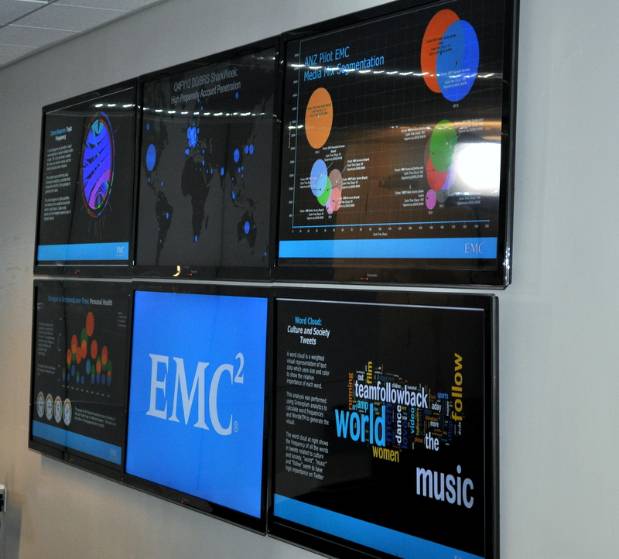Our CMO Jeremy Burton is a visionary, always at least three steps ahead of the pack. I identified this gift early on, recalling Jeremy’s ability to excite a very calm and composed Technology Marketing team at Oracle 12 years ago through innovative ideas. I knew he was on the rise – Big and Fast. Yes, pun intended. Today, Jeremy’s vision at EMC is not only to harness Big Data to build a data-driven Marketing organization, but also to inspire other organizations to do the same in their Marketing departments through EMC’s Marketing Science Lab.
The Marketing Science Lab, built on EMC Big Data technology, provides a 360 degree view of customers in order to better understand their behavior and sentiment and improve marketing effectiveness. The Marketing Science Lab is not only accessible to EMC Marketers, but also presents itself through a highly visual dashboard application at EMC’s Executive Briefing Center in Santa Clara, CA. EMC’s Michael Foley leads the Marketing Science Lab and provides us with more insight into how this Big Data project is transforming EMC’s business and making everyone in Marketing addicted to analytics.
1. Can you describe the Big Data technology behind the Marketing Science Lab?
In order to support Jeremy’s vision of a data driven organization, we wanted to make sure that every marketing program can leverage Big Data analytics to make better decisions around customer segmentation, targeting, lead generation, predict future behavior, media mix optimization, improve brand awareness, and more.
This required us to use Big Data technologies, specifically EMC Greenplum and Isilon, to enable us to collect, manage, and analyze more information about our customers –historical company data (such as past purchases), contact demographics, interests and marketing history, unstructured data, etc. The more information we can gather and analyze, the more precise we can be with customer profiling, for example.
Our data is set-up on a Greenplum 100-node DCA (Data Computing Appliance). For access and analysis, we use tools such as PGAdmin/PostgreSQL, Greenplum Chorus, Tableau, R, SAS, GP’s MADlib, GPText, and Hadoop. Our Marketing Data Science team works daily with IT and Lines of Business to provide the right data sets and analyses. Greenplum Chorus is great because it provides us ease of collaboration with data scientists in other EMC disciplines (such as Sales and IT) without having to pick up the phone and start a webex session to fulfill requirements. And because we are on a Greenplum 100-node DCA we can easily create and manage data in our sandbox and get all the benefits of massively parallel processing for fast data analysis and modeling using tools such as PostgreSQL, R, SAS, MADLib, GPText, and more.
2. What were some of the challenges of the project?
It took us six months to deploy our team on a 100-node Greenplum Database, providing a 360-degree view of our customers. The biggest challenge was data integration because we wanted to import data from a lot of different sources to improve the quality and completeness of our marketing contacts. With the help of the EMC IT and Greenplum architects, we were able to successfully integrate the data. The second challenge was user adoption – in order for the project to be successful, the marketing organization had to become addicted to analytics when making decisions. We launched the Addictive Analytics training course internally to ensure the Marketing Science Lab was exposed and leveraged for marketing programs moving forward.
3. How has Big Data solved some of the problems associated with marketing analytics?
There are so many areas that have improved with this Big Data project because we now have more data points, and more horsepower. We can now use high-speed, advanced analytics against a single-source-of-truth containing over 1,300 tables of detailed data that is now shared and agreed-upon by users in Sales Ops, Finance, Manufacturing as well as Marketing and Operations to give us a unified go-to-market view which solves many problems:
-For more accurate targeting, we can now use machine learning instead of static business rules for propensity modeling.
-Data scientists and BI analysts across EMC can access a 360-view of customers – which marketing leverages for targeting, planning, reporting, lead management, campaign management, and response modeling — without experiencing poor query performance due to heavy workloads.
-Going forward, we now have the space and computing power to work on joining structured enterprise and unstructured sales chat and social media data for more accurate marketing analysis.
-Fast, dynamic visualizations through Tableau are now possible to present insights versus static charts in PowerPoint.
4. Can you describe some EMC Marketing use cases and benefits seen thus far?
Our Marketing Data Scientists have already partnered with Sales, Marketing, and IT colleagues to work on a wide range of projects, including:
-Data visualization and text-mining a billion tweets and 170 related variables from the Twitter firehose for the Human Face of Big Data brand campaign.
-Heavy data manipulation joining data from many different sources to target lists for multi-channel campaigns such as Inside Sales Global Shark Weeks.
-Employing the latest machine-learning techniques to score contacts based on their propensity to become a lead – for more precise targeting through our marketing CRM application.
5. The Marketing Science Lab is open to customers visiting EMC’s Executive Briefing Center. What are CMOs most excited about when seeing the lab?
CMOs are excited to see that Big Data can scale to address the full spectrum of marketing issues around lead generation, customer segmentation, media mix optimization, and new applications like understanding the customer journey contiuum (where always-on marketing can replace the leads funnel), mining social data to discover sentiment, and more. Additionally, new insights can be discovered since Big Data can bring together and mine unstructured data (social media data, sales chat data, etc.), as well as structured data (such as leads pipeline data). Lastly, Marketers themselves can leverage new, dynamic visualization techniques against data sets of any size and type to make better decisions and generate revenue.
